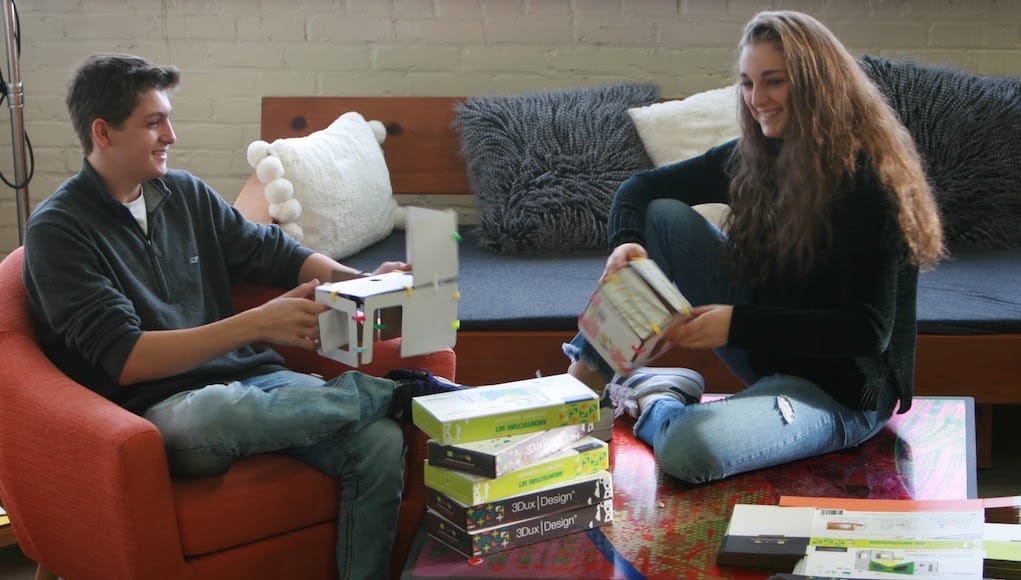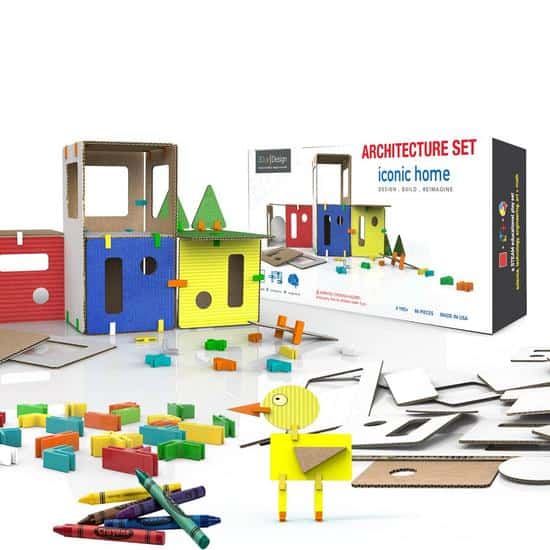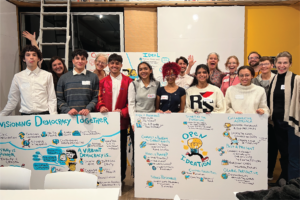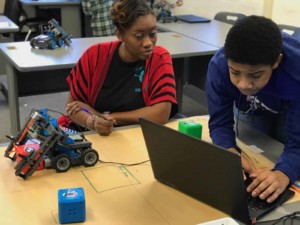3Dux|Design: Out-of-the-Box Thinking, Right Out of the Box

By: Erin Gohl & Kristen Thorson
A persistent struggle and goal for today’s schools and families are ensuring that students are ready for the challenges of the 21st century. This ambition is no longer a forward-looking, ancillary hope as all of today’s K-12 students were born in the 21st century. Rather, innovative and design thinking must be a primary component of student learning in order to ensure life-readiness.
In doing this, there are several themes that today’s educators find to be characteristic in implementing curriculum and pedagogy distinct from classroom experience of the past. Districts around the country are implementing programs focused on problem-based learning, STEM (science, technology, engineering, and math), social-emotional learning, and interdisciplinary deeper learning in order to provide students at home and in school with experiences, knowledge and attitudes in today’s classrooms to help them be successful in tomorrow’s world.
The best of these kinds of educational approaches facilitate learning in a way that emphasizes process over product while creating pathways that allow for innovative thinking that seeks to address real-world issues and problems. A significant challenge for teachers and parents in meeting these ambitions is finding materials for student use that are flexible to learner ages, adaptable across content disciplines, extendable to new applications, simple to implement, affordable, able to be used at school and at home, and appropriate for core instruction, remediation, and enrichment. It is a big task.
One company that has responded to this need is 3Dux|Design. Founded by two teenagers and their parents, 3Dux|Design has developed a cardboard-based modeling system and accompanying curricula that meet the highest level of this criterion for authentic, problem-based, innovative learning.
Connections Enable Creations
3Dux|Design provides a base set of materials to enable users to engage in engineering, architectural design, artistic expression, and construction. The magic is the simplicity: the materials are pre-cut cardboard, a set of connectors, and an initial set of instruction designs. Their combo set website description says it well: “Each set includes geometric shapes, connectors, and crayons to create the featured structure in the set, as well as additional pieces to expand the set or to build your own creation!”

In addition to working with the kit’s cardboard pieces, the 3Dux connectors fit most standard shipping box cardboard so students are able to “recycle and make [their] own shapes for endless creativity.” And because the connecter pieces can be used with any standard cardboard box, the possibilities for creation are essentially boundless. Ayana Klein, who co-founded 3Dux|Design while in high school, explains the value of the flexible and environmentally-friendly nature of the product: “I feel that most building sets on the market limit young children’s creativity with pre-formed, rigidly designed, and costly kits while cardboard is free, sustainable, and limitless in form.” With the 3Dux|Design product, “children never run out of raw material to work with, have the ability to make their own shapes, and learn about creative repurposing while they construct.”
3Dux|Design has packaged several versions of architectural modeling sets that blend the arts, humanity, and open-ended creative thinking that naturally fit within STEAM education. Through “Design Challenges” found on the company’s website, builders are encouraged to consider not just the math and science around their engineering, but also the more global impact of the environment and the people who could utilize such structures as they construct. As the company explains, a primary goal for utilizing these building sets is to “encourage children to imaginatively and practically think through solutions to real-world problems by building structures and environments.” The nature of these lessons allows for multiple pathways to success on authentic problems, and an iterative process of design and redesign to achieve students’ desired outcomes.
In Homes, Schools, Makerspaces and Beyond
3Dux|Design is now used in over 350 schools, makerspaces and museums across the States and abroad. The company has partnered with educators to develop curricula for schools, museums and STEM programs that pair with their materials, making STEM learning easy to facilitate across grade-levels and fit various programming needs. They offer lesson plans, such as an assignment for students to build a home with all necessities under 150 square feet. 3DuxDeisgn provides open-ended design challenges like the charge to help a group of aeronautical engineers imagine, design and build a model to help cross the Elbe River in Hamburg Germany. There are also curricula that help build a more substantial program, offering a 6-12 week plan for enrichment, where students become the team of designers tasked with renovating an old factory site to meet the needs of a community.
This past summer, the company spearheaded the 3Dux Global Architecture and Urban Design Program, a pilot project that spanned over 14 countries (including Kenya, New Zealand, Hong Kong, Benin, Indonesia, Canada, Costa Rica and more). This initiative aimed to integrate architecture, urban planning and design thinking, engineering, environmental stewardship, and global collaboration and communication. Using 3Dux materials, students created 3D models that told about their own home community. They then used photography and videography to share more about their culture and their lives. This pilot was a precursor to a broader global project-based learning program that will launch later this month. The program will encourage students to build models of sustainable cities of the future, with a focus on the United Nations Sustainable Development Goals.
Wonderfully Simple and Endlessly Engaging
The versatile nature of the connectors, the design of the initial templates, and the support of the curricular materials and broader 3Dux community make 3Dux|Design a compelling resource. These sets serve as both precursors for and extensions of many more advanced and electronically-enabled resources that have saturated the market in recent years. Computer-aided design, historical and contemporary architecture, and principles of physics and engineering are the obvious applications. But emerging technologies will also likely be able to be integrated with these resources. Augmented reality can place the creations in environments around the globe and across time. Virtual reality might enable the constructions to be uploaded and digitally enhanced.
The wonderful reality is that those extensions are not required to make 3Dux|Design relevant. Out of the box, the sets are usable in rural and urban communities, both indoors and outdoors, in classrooms and living rooms, and for people of all ages. Creativity and play are appropriate for everyone. And replenishing the materials is as simple as keeping the packaging from the direct to consumer shipping and promoting a culture of green, carbon-neutral, construction. 3Dux|Design is wonderfully simple and endlessly engaging.
For more, see:
- The Case for School Makerspaces According to Those Who Use Them
- 8 Examples of the Future of EdTech, Fresh from FETC
- Thinking With Your Hands
Stay in-the-know with all things innovations in learning by signing up to receive our weekly Smart Update.








0 Comments
Leave a Comment
Your email address will not be published. All fields are required.